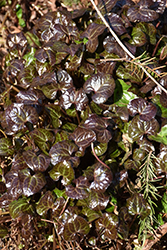It's all about ...
plants

Ginger-leaf False Bugbane
Beesia calthifolia
Height: 10 inches
Spread: 12 inches
Sunlight:
![]()
![]()
Hardiness Zone: 6b
Description:
An outstanding foliage plant for the woodland garden that is very impressive massed; heart shaped leaves emerge bronze and mature to glossy green with pronounced veins, then progress to deep maroon in winter
Ornamental Features
Ginger-leaf False Bugbane's attractive glossy heart-shaped leaves emerge coppery-bronze in spring, turning dark green in colour with distinctive light green veins on a plant with a mounded habit of growth. As an added bonus, the foliage turns a gorgeous plum purple in the fall. It features dainty spikes of lightly-scented white flowers rising above the foliage from early to late summer.
Landscape Attributes
Ginger-leaf False Bugbane is a dense herbaceous evergreen perennial with a mounded form. Its relatively coarse texture can be used to stand it apart from other garden plants with finer foliage.
This is a relatively low maintenance plant, and is best cleaned up in early spring before it resumes active growth for the season. It has no significant negative characteristics.
Ginger-leaf False Bugbane is recommended for the following landscape applications;
- Groundcover
Planting & Growing
Ginger-leaf False Bugbane will grow to be about 8 inches tall at maturity, with a spread of 12 inches. Its foliage tends to remain low and dense right to the ground. It grows at a medium rate, and under ideal conditions can be expected to live for approximately 10 years. As an evegreen perennial, this plant will typically keep its form and foliage year-round.
This plant does best in partial shade to shade. It requires an evenly moist well-drained soil for optimal growth, but will die in standing water. It is not particular as to soil pH, but grows best in rich soils. It is somewhat tolerant of urban pollution. Consider covering it with a thick layer of mulch in winter to protect it in exposed locations or colder microclimates. This species is not originally from North America. It can be propagated by division.
This plant is not reliably hardy in our region, and certain restrictions may apply; contact the store for more information.
